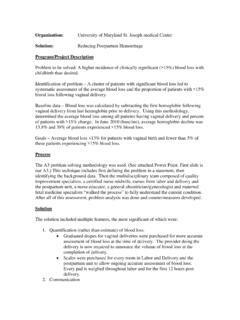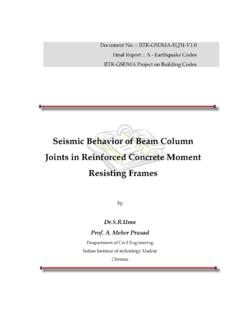Transcription of The National Insititute for Elopement Prevention ...
1 For educational use only . Not intended for implementation . The National Insititute for Elopement Prevention & Resolution Elopement Prevention and Resolution POLICY. The role of policy in Elopement planning has two major and important functions. Its first major function is to attempt to prevent elopements. The best Elopement is the one that never occurs. The second major function is to direct what actions are to be taken when an Elopement does occur. I believe that there is no such thing as an Elopement proof . facility. The goal of this educational program is to teach you how to make your facility safer, reduce the potential for elopements, improve the prospect for a quick resolution to the Elopement incident, and to help prepare your facility for potential litigation.
2 How can a policy prevent an Elopement ? The first step is a policy that defines the assessment for potential Elopement . This must define when and how you assess EACH patent for their Elopement risk. Many facilities make the mistake of only assessing the patients they deem to be an Elopement risk. To protect your facility in this litigious society, you must assess ALL patients for Elopement risk. When writing a policy to assess Elopement risk, you must define several areas of the assessment. First you should address how you will assess and document the patient's risk for Elopement . Next you must define when your facility will assess the patient for Elopement risk. Obviously this should be done at admission for ALL patients, but certain patients need to be assessed more often.
3 These include the patient suffering from dementia or those with a known history of wandering behavior. Finally, the policy needs to define procedures that will be used to attempt to prevent Elopement for each predetermined level of risk. A key word you should always use in policies that deal with Elopement Prevention is ATTEMPT. Remember, there is no such thing as an Elopement proof facility; as such any policy should be worded to attempt to prevent Elopement . This can be a great advantage should you find yourself in court after an Elopement incident. Many facilities are spending great amounts of money for new state-of-the-art . containment systems. These are often used only in certain parts of the facility for patients that are deemed to be at risk for Elopement .
4 These are great assets to facilities but again any policy regarding these units should be worded to attempt to prevent Elopement . The same is true for any device approved for use by your facility to attempt to prevent Elopement . For educational use only . Not intended for implementation . Copyright 2002. 1. For educational use only . Not intended for implementation . When developing policy to prevent elopements, we should also look at the current general policies and revise them to address Elopement risk. How many of your facilities address specifically those at risk for Elopement in their Disaster Plans? Where will those in the special care unit go if there is a fire within their unit? How will their risk for Elopement during this time be addressed? The next step is to develop a policy to define what actions your facility will take when you learn that a possible Elopement has occurred.
5 I believe that the best way to do this is to develop an Elopement Response Plan. By having an Elopement Response Plan, the policy can simply state that should an Elopement occur, this plan will be implemented. Many facilities have policies that state they will conduct a search of their facility and notify local law enforcement. While this may seem to be a complete answer, once you see a high quality Elopement Response Plan, you'll see why this is a much better way to deal with a possible Elopement incident. The final issue to deal with in Elopement policy is education of staff. This is a vital policy and should address that ALL staff members are trained in the Elopement Prevention and response plans. You will likely use all available staff to assist should an Elopement occur; this is why ALL staff members need to have training in your Elopement policy and response plan.
6 You will need to also address when and how often staff members are trained. ALL staff should have training in this area as part of their orientation training when they are hired. The nursing and administration staff should have annual training in Elopement policies and plans. These should include how and when to report elopements to the appropriate agencies (State, JCAHO, etc ). Your facility might also consider an Elopement exercise in addition to training. Having a mock Elopement and listing this in a policy helps provide hands on training for staff that will be working an actual Elopement . It also helps to show any weaknesses in your plans so that they can be corrected before an actual Elopement occurs. This could be very beneficial in a post Elopement litigation situation.
7 Being able to show that you are testing your plan for compliance and workability could greatly influence a jury. I cannot stress enough the need to have high quality plans and policies for dealing with Elopement . You also need to have a plan for how your facility will investigate actual/suspected Elopement responses and policy when an Elopement occurs. Unfortunately, many facilities do not realize this until they have an Elopement incident that leads to litigation. Should you find yourself in a litigation situation regarding an Elopement , you will be asked many different questions about your facilities Elopement policy and training on that policy. As a CLNC (Certified Legal Nurse Consultant), I advise lawyers where the strengths and weaknesses are in a facilities policy.
8 I should warn you that a policy that is not consistently trained on and enforced is a very big liability to a facility. For educational use only . Not intended for implementation . Copyright 2002. 2. For educational use only . Not intended for implementation . Elopement Assessment Documentation The annual assessment of facilities and policies will be placed in a report form and reviewed by the safety committee and PI. The final copy will be placed in the next corporate meeting minutes. The patient/client Elopement assessments will be documented on the patient/client admission record and a copy will be placed in the patient/client chart. STATE GUIDELINES AND STANDARDS. Each state has their own set of guidelines or standards that govern Elopement policy and plans.
9 These guidelines or standards are only the MINIMUM required by the state. The fact that your facility meets these minimum guidelines or standards will not protect you in the civil court system. It will only protect you from additional actions by the state should an Elopement occur. You should maintain a current copy of your state guidelines or standards regarding Elopement and place them in your policy binder. Once you have developed the policies and plans for your facility, return to the state guidelines or standards and review how your policy and plans meet and exceed these guidelines or standards. You might want to review the CMS 7-Key Components referred to in CMS appendix Q and in particular Attachment C. This is very important, as you may be required at any time to do the same for state or federal inspectors.
10 Understand that the goal is to exceed your state/federal guidelines or standards thereby protecting the population you serve. By doing this, you will also be protecting your facility in the civil litigation arena. The team should be familiar with the recommended Key Components of an entity's systematic approach to prevent abuse and neglect. The seven Key Components include: screening, training, Prevention , identification, investigation, protection, and reporting/response. (Refer to Attachment C) Both Appendix Q and the Key Components apply to all certified Medicare/Medicaid entities.. Another regulation that all facilities should review is the new CMS at F323 . (July 6, 2007) F323 and F324 Tags are combined into a new F323. Under Definitions, there is still no official definition of Elopement .















